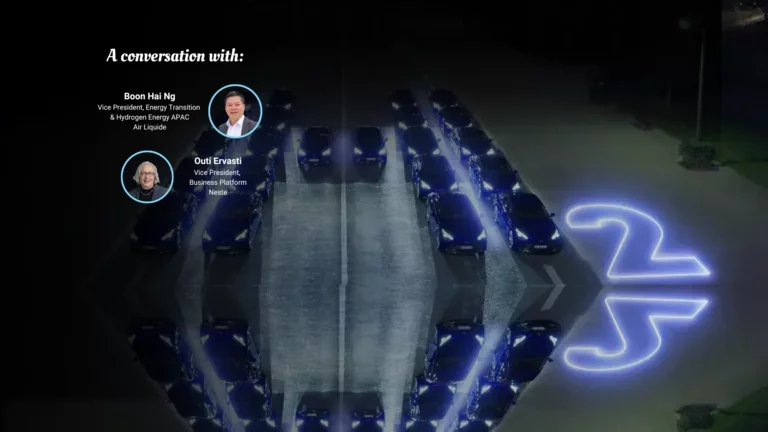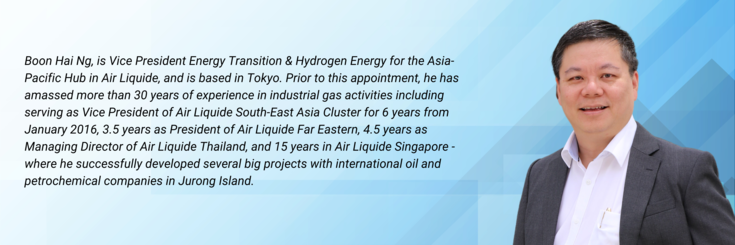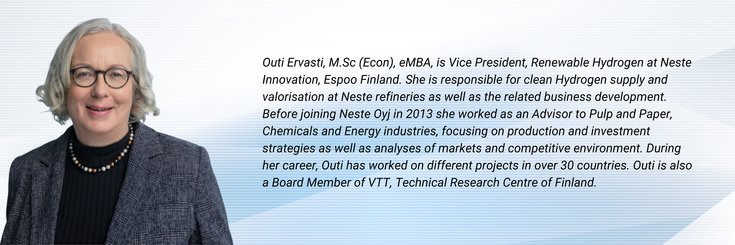Hydrogen & the Energy Transition: Hype or Game-changer?
Published on May 17, 2023
8 minutes

Article available in Chinese, Japanese and Korean:
-
Chinese
Download the document PDF (671.31 KB) -
Japanese
Download the document PDF (714.4 KB) -
Korean
Download the document PDF (526.22 KB)
With countries around the world launching national decarbonisation strategies involving hydrogen, is hydrogen merely hype or is it indeed a game-changer? Can hydrogen serve as the fuel of the future? We invite Ng Boon Hai from Air Liquide and Outi Ervasti from Neste, to share their expert opinions.
Hydrogen and the Energy Transition: Hype or game-changer?
Hydrogen is key when it comes to decarbonising heavy industries on a large scale. The need for decarbonisation is urgent – today, heavy industries and traffic account for nearly 40 per cent of all global greenhouse gas emissions.
Currently, around 95 per cent of all hydrogen is made of fossil feedstocks, which leads to significant greenhouse gas emissions. If renewable power is available, hydrogen can be produced emission-free and will represent a massive potential to help meet our rising energy demand and contribute to global climate goals.
Renewable hydrogen is produced by electrolysis, where hydrogen is processed from water using renewable electricity, such as wind or solar, by splitting water molecules. It provides a clean, scalable, and versatile energy source for carbon-intensive processes such as steel, cement, and chemical production. In transportation and traffic, and especially in the aviation industry, renewable hydrogen has the potential to significantly reduce greenhouse gases and become a competitive e-fuel alternative by 2030 and beyond.
I firmly believe that hydrogen will help us to respond to the climate emergency and the needs of populations and businesses. The diverse applications of hydrogen only mean that it is a versatile product, which we can turn into an effective solution for decarbonisation.
Apart from being a key element in many industrial processes and even being used as rocket fuel, hydrogen is an energy carrier that can be stored and transported on demand to power transportation, homes, and industries. It’s no wonder hydrogen is in the spotlight - it has the potential to decarbonise our energy mix if coupled with renewable power or carbon capture.
Hydrogen is certainly a means to slow down climate change. We at Neste see that in addition to more widespread hydrogen use in the future, multiple other means to reach carbon neutrality are needed as well.
On this point, we are certainly aligned with Neste. Indeed, carbon neutrality requires a multi-faceted approach with multiple pathways but as Outi and I have reiterated, we are convinced that hydrogen will play a key and central role on this decarbonisation journey.
What are your views on hydrogen in the Asia-Pacific region?
Asia-Pacific (APAC) is facing a complex challenge – a combination of growing energy consumption to fuel economic growth and the pressing, concurrent need to decarbonise that energy mix in order to meet national commitments to carbon neutrality. In numbers, nearly 50 per cent of the combined volume of the top 10 energy-consuming countries come from APAC. Industry has to pivot towards lower carbon if not renewable energy sources, and this is where hydrogen produced through renewable sources has an immense potential to accelerate the decarbonisation effort. Countries like China, Japan, South Korea, Australia, and Singapore see the potential of hydrogen to be a key enabler of the energy transition in the industrial, power, and mobility sectors and have already incorporated hydrogen into their national strategies. The versatility, scalability and potential for large-scale production make it a game-changer for the transition towards a carbon-free future.
Indeed, the transition to a green hydrogen economy is just getting started, and the path to large-scale adaptation of renewable hydrogen needs pioneers to lead the way. Focus on renewable hydrogen is an essential part of Neste’s strategy and our goal to reach carbon neutral production by 2035. At the moment, Neste is working on renewable hydrogen and clean hydrogen projects to decrease the carbon footprint of its refineries and in order to be able to offer its customers high-quality fuels with low carbon intensity.
Similarly, Air Liquide is actively involved in advancing the production and utilisation of renewable hydrogen as part of its commitment to sustainable development. As a pioneer in hydrogen technologies, Air Liquide has been involved in numerous projects worldwide, to develop large-scale electrolysis units powered by renewable energy sources to produce hydrogen with zero carbon emissions. In regions with poor access to a renewable source, steam methane reforming coupled with carbon capture is a viable alternative. Air Liquide is also involved in providing hydrogen solutions for transportation, including hydrogen refuelling stations for fuel cell vehicles.
What role does hydrogen have to play in your processes?
In Singapore, we use hydrogen in a catalytic process called hydrodeoxygenation, during which oxygen atoms are removed with hydrogen atoms from the oils and fats that we use as our 100 per cent renewable raw material base to create a pure hydrocarbon with high energy density. Currently, the majority of the hydrogen we use for our production is sourced from third parties locally in Singapore. However, with our Singapore expansion project, we will have capacity to produce part of the hydrogen we need for our production by ourselves.
And at Air Liquide, we are committed to find a pathway to support the decarbonisation objectives of companies like Neste, innovating and developing technological bricks along the hydrogen supply chain, from producing, storing, transporting, enabling the utilisation of hydrogen through efficient and safe means. As a step towards our decarbonisation ambition, many projects across the world are underway to increase Air Liquide’s production capacities in renewable and low carbon hydrogen such as in the case of our new hydrogen production units with carbon capture technology in Shanghai Chemical Industry Park, announced in 2022
Is it possible to produce enough clean hydrogen to meet APAC’s energy needs, given the limitations on technology, infrastructure and cost?
We have witnessed an increasing interest in the hydrogen economy in various APAC countries. In addition to active development of domestic economies towards hydrogen use, e.g. China, South Korea, Singapore, countries such as Australia and India are also involved in developing hydrogen for exports. The potential of renewable energy sources, e.g. wind and solar energy, varies remarkably by country, so how the APAC countries approach hydrogen varies accordingly.
Again well said by Outi. Hydrogen is certainly not intended to be the silver bullet to all of APAC’s energy problems, but it is an integral solution for traditionally fossil-based industries. For example, in the mobility sector, while many automotive OEMs currently pursue battery electric vehicles, hydrogen is in fact more suitable for heavy duty vehicles and long distance transportation thanks to its higher energy density by mass and shorter refuelling time. In maritime and aviation, hydrogen could also provide an ideal and safe zero emission clean fuel solution as opposed to other low carbon fuels like ammonia and liquefied natural gas. Hydrogen provides a complement to other options in answering the emission challenge in the mobility sector.
On the topic of mobility, how do you see hydrogen mobility evolving?
Air Liquide sees the potential in hydrogen for mobility and has long started developing the technology needed – from offering low carbon and renewable-based production, conditioning and distribution of both gaseous and liquid hydrogen, to proprietary hydrogen refuelling technology, our expertise cuts across multiple industries with a proven track record.
In anticipation of the demand for clean hydrogen, Air Liquide also partners established original equipment manufacturers to generate solutions with high degrees of efficiency and which are suited to harvest volatile renewable energy.
Overcoming technological challenges is the first step. The industry needs the support of governments’ regulatory schemes to fully capitalise our technologically robust and scalable hydrogen supply solutions, which we hope to see replicated from the US (e.g. Inflation Reduction Act) and Europe to APAC in the coming years.
What can we look forward to from Neste in the APAC hydrogen scene in the coming years?
Renewable hydrogen enables production of low-emission fuels and other refined products. As part of Neste’s growth strategy we continue to focus on innovation, in which renewable hydrogen is one of our key development areas.
We have recently established an innovation centre in Singapore which in the future can function as a centre for Neste-driven collaboration regarding hydrogen-related topics in the APAC region.
At the moment, we are investigating sustainable hydrogen options for our refinery in Singapore. As a first step toward the use of renewable hydrogen for our processes, we have just started to use biogenic off-gas to fuel our newly constructed hydrogen production unit. Moving forward, we are also proactively working with the authorities and partners to support the widespread usage of green electricity and hydrogen. Our future approach depends on the renewable electricity available in Singapore, logistics options for hydrogen, regulation and the hydrogen-related requirements among our customers.
What is Air Liquide’s key focus for hydrogen in APAC moving forward?
Air Liquide’s mastery of hydrogen is decisive, but this mastery alone is not enough as a whole ecosystem needs to be created. We will continue to work with governments and partner with industry leaders, retailers, and automotive players to accelerate hydrogen mobility and activate the maritime and aviation markets.
This has been demonstrated in South Korea: Air Liquide joined forces with national conglomerate Lotte Chemical to pave the way for new hydrogen supply chain infrastructure, with filling centre and liquefier projects in the pipeline; Air Liquide, Airbus, Korean Air, and Incheon International Airport Corporation is also working together to develop a hydrogen ecosystem at and around Incheon airport. Similarly in China, Air Liquide, Shenergy and Shanghai Chemical Industry Park have partnered to accelerate the deployment of hydrogen mobility in Shanghai. Air Liquide also aims to replicate such collaboration in other parts of China such as the Jing-Jin-Ji region.
A future with hydrogen is not far away. Air Liquide, like Neste, intends to move forward hand in hand with all stakeholders of the hydrogen industry and be a key contributor to national hydrogen and decarbonisation strategies in APAC.

